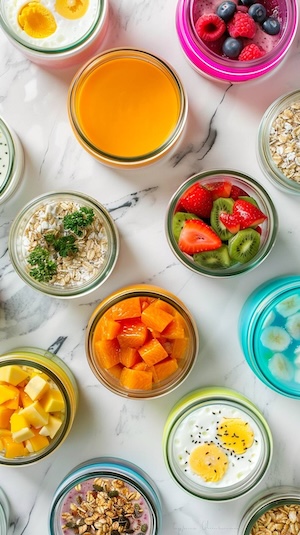PCOS for Picky Eaters: 30 Simple Meal Ideas
Discover 30 simple pcos meals for picky eaters that help manage symptoms. Easy pcos meals picky eaters will love, with practical tips and hormone-balancing ingredients.
Full recipe here: http://blog.maangchi.com/2008/03/rice-cake-gyung-dan.html There are many different kinds of rice cake, but I'm going to introduce gyung dan to you. On special occasions, the first thing my mom and grandmother did was to prepare rice cake, so this is what I'm going to show you. Ingredients: 1. 2 cups of sweet rice flour (Mochiko powder) 2. 3/4 cup of boiling water (or 1 cup) 3. salt, sugar, brown sugar 4. 1 cups of red beans 5. 1 ts of cinnamon powder 6. black sesame seeds powder 7. mugwort powder 8. toasted yellow soy bean powder, and 1 or 2 cups of flour Step 1: Make red bean paste 1. In a pot, place 1 cup of washed red beans and 4 cups of water and heat it over high heat for 10 minutes. 2. Lower the heat to low medium and simmer for 50 minutes. 3. Check if the beans are cooked fully. Remove extra water from the beans and crush them with a wooden spoon. 4. Add 1 cup of brown sugar, 1 ts of salt, 1 ts of cinnamon powder into the red bean paste and set it aside. Step 2: Prepare 3 bowls where 3 different kinds of powder will be placed for the rice cake balls 1. Black sesame seeds: Rinse and drain ½ cup of black sesame seeds in running water using a strainer. Heat a pan over medium heat and pour in the sesame seeds. Cook the sesame seeds by stirring with a wooden spoon. The sesame seeds will pop, then lower the heat and keep stirring until they are crispy. (5- 10 minutes) When the sesame seeds cool down, grind them with a coffee grinder. Transfer the sesame seeds powder to a bowl and add 2 tbs sugar and a pinch of salt and mix it. 2. Put ½ cup of toasted soybean powder (kong gaa ru in Korean) in a bowl and add 2 tbs of sugar and a pinch of salt and mix it. 3. Put ½ cup of mugwort powder (ssook gaa ru in Korean) in a bowl and add 2 tbs of sugar and a pinch of salt and mix it Step 3: Make rice cake dough. 1. In a bowl, place 2 cups of sweet rice powder, 2 tbs of sugar, 1 ts of salt. 2. Pour 2/3 cup of hot water little by little while you are mixing it with a spoon 3. Mix the dough by hand. *tips: if you feel the dough is too wet, add some plain flour 4. Put the rice cake dough into a plastic bag and set it aside Step 4: In a big pot, place a lot of water and boil it Let's make rice cake! 1. Take the rice cake dough out from the plastic bag and place it on the cutting board. Tip: To protect the dough from being stuck to the board, sprinkle some plain flour before placing the rich cake dough. 2. Divide the dough into 2 and roll each one to make cylinder shape and cut it into 18-20 pieces. 3. Roll each piece of rice dough with your hands and make a hole in the middle of the ball with your thumb. Then turn the ball into a cup. 4. Put the bean paste into the middle. 5. Close it tightly and place it on a plate. Tip: While you are making rice balls, the rest of dough may get dried, so cover them with wet cloth or paper towel. 6. Carefully put all the rice cake balls into boiling water. When the rice cake balls are cooked, they float. It will take about 3 -5 minutes until they float. 7. Prepare lots of cold water in a big bowl. 8. Put the cooked rice balls into cold water and drain them. 9. Roll the cooked rice balls in the 3 different colors of powder and transfer them to a plate. Enjoy it!
This recipe includes superfoods such as:
Transform your health with tailored 7-day meal plans designed specifically for PCOS management. Just $7/month or $59/year.
Get it now →See video for ingredients
See video for instructions

You know the drill: Alarm goes off. You hit snooze. Rush around frantically. Skip breakfast AGAIN because there's no time. By 10am, you're hangry, your blood sugar is all over the place, and your PCOS symptoms are already acting up.
Sound familiar?
Finally – a meal prep system designed specifically for women with PCOS who refuse to let chaotic mornings derail their health goals.
In just ONE hour on Sunday, you can transform your entire week:
"I went from skipping breakfast 4 days a week to having delicious, hormone-supporting meals ready every morning. My energy is more stable and my cravings have disappeared!"
– Sarah M.
Stop letting chaotic mornings control your health.
Get your hormone-happy mornings starting this Sunday.
→ Get Your 60-Minute Solution Now
Transform your health with tailored 7-day meal plans designed specifically for PCOS management. Just $7/month or $59/year.
Get it now →Serving Size: 0
| Amount Per ONE Serving | ||
|---|---|---|
| Calories 0 kcal | ||
| Fat 0 g | ||
| Carbohydrate 0 g | ||
| Protein 0 g | ||
💡 Introducing the 10/10 PCOS Solution:
Ten Delicious Crockpot Recipes that take just 10 minutes to prep!
Say goodbye to hours in the kitchen and hello to clean, PCOS-friendly meals made effortlessly.
👉 Click here to grab your 10/10 PCOS Solution today! Try The 10/10 PCOS Solution: Ten Crockpot Recipes That Take Just Ten Minutes to Prep
Managing PCOS can be challenging, but you don't have to do it alone. Join our supportive community to connect with others who understand what you're going through, share tips, and get encouragement. Here's how you can get involved:
Subscribe to our Newsletter: Receive PCOS-friendly recipes, tips, research updates, and more delivered straight to your inbox. Stay informed and empowered with the latest information and support.
Join our Telegram Channel: Stay updated with the latest tips and advice on managing PCOS.
Follow PCOS Meal Planner on Facebook: Engage with our community, participate in discussions, and get support from others.
Break the cycle with the PCOS Meal Planner - your personalized guide to eating better, feeling better, and managing PCOS symptoms. Take control today!

Forget the frustrating cycle of weight loss attempts, endless medications, and living in discomfort. Introducing the PCOS Meal Planner. A meal planning guide that goes beyond temporary fixes to offer a comprehensive strategy, empowering you to ignite a transformation towards lasting health and happiness. Step into a world where you control your PCOS, not the other way around.
Unlock Your PCOS Freedom Now.
Discover 30 simple pcos meals for picky eaters that help manage symptoms. Easy pcos meals picky eaters will love, with practical tips and hormone-balancing ingredients.
Discover 15 delicious overnight oats for PCOS recipes that help balance hormones and manage symptoms. Easy, nutritious breakfast ideas perfect for women with PCOS.
Discover the best cereal for PCOS with our expert rankings. Compare brands, check ingredients, and find PCOS friendly cereal that supports hormonal balance.
Learn how to transition away from fruit when starting a ketogenic diet for PCOS. Discover gradual strategies, fruit alternatives, and practical tips for success.
Discover 5 delicious PCOS banana bread recipes with low-glycemic ingredients. Learn how to make hormone-friendly banana bread that supports blood sugar balance.
Creatine for women with PCOS explained simply. Learn safety, benefits, hormone effects, tips, and how creatine may support PCOS symptoms naturally.
Complete PCOS diet plan with foods to eat, foods to avoid, meal timing, and real results. Learn the science-backed approach to managing PCOS through diet, with 7-day meal plan, grocery list, and step-by-step implementation guide. Based on clinical research and real patient outcomes.
Complete guide to ordering at Wendy's with PCOS. Discover the best protein-focused meals, what to skip, and how to customize orders to keep blood sugar stable. Learn which burgers, salads, and sides work for PCOS, plus complete macros for every menu item and smart swaps to avoid insulin spikes.
Complete guide to ordering at Burger King with PCOS. Discover the best protein-focused meals, what to skip, and how to customize orders to keep blood sugar stable. Learn which burgers, salads, and sides work for PCOS, plus complete macros for every menu item and smart swaps to avoid insulin spikes.